|
Cincoze GM-1000
Compact, vastly configurable embedded GPU industrial Box PC full of innovation and almost endless application potential
(by Conrad H. Blickenstorfer)
Cincoze calls their new GM-1000 an embedded GPU computer. They arrived at this description as follows: The Cincoze GM-1000 is, of course, a computer, one with up to 8 high-performance processing cores and 16 threads doing all the usual things a modern computer does — heavy multi-tasking, powering through serial tasks in multiple threads. But the Cincoze GM-1000 is also built to accommodate specialized graphics processing units via Mobile PCI Express Modules. Those can have hundreds or even over a thousand cores, perfect for parallel processing of specific complex tasks. Then the GM-1000 is designed as an embedded system, i.e. a compact, rugged, utterly reliable part of a task-oriented process or system.
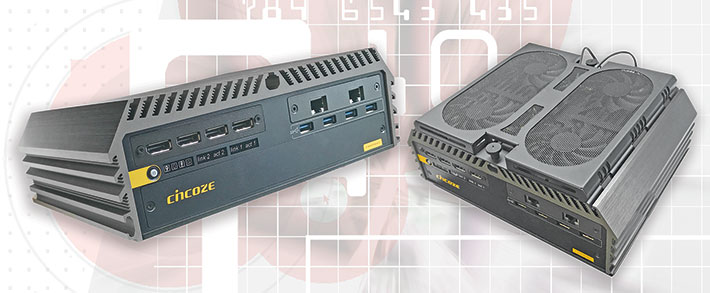
What is the Cincoze GM-1000 for? All sorts of things that require a combination of high-performance computing and high-speed optical analysis and recognition. That includes machine visions tasks, such as automated optical inspection, automated sorting or vision-guided robotics. Video surveillance is on the list, with comprehensive site monitoring, facial recognition, and behavioral prediction algorithms. In transportation, systems like the GM-1000 are deployed for tasks such as autonomous driving, blind sport detection, or driver fatigue recognition. On a higher level, there's also overall traffic monitoring, license plate recognition, or even baggage screening.
Steel, aluminum, copper
The image below shows the Cincoze GM-1000 from the top and all four sides. The device consists of aluminum front and back plates with polycarbon fascia (and more steel inside) with cutouts for the various ports, and large, prominent finned aluminum heat sinks/spreaders. There is no fan on or in the unit itself; by default heat is conducted away from the Cincoze GM-1000's CPU and other electronics to the large metal heat sinks via heat-conducting material and then dissipated to the air. Our review unit had no problems keeping things cool with its 35 watt TDP processor. However, there's more to thermal management than meets the eye with this industrial PC, and we'll get into that a bit later.

The Cincoze GM-1000, like most compact industrial PCs, is a simple and straight-forward design, a precision-engineered piece of computing machinery of very high quality. The design is rational down to the smallest detail. Compact and integrated enough to make for a fairly compact package, but large enough to easily accommodate a good number of industry-standard PC ports and modules. Do note, though, that while the Cincoze GM-1000 doesn't have a fan or ventilation slots, it is not a sealed unit (and doesn't claim to be).
The picture below shows the system from the front:
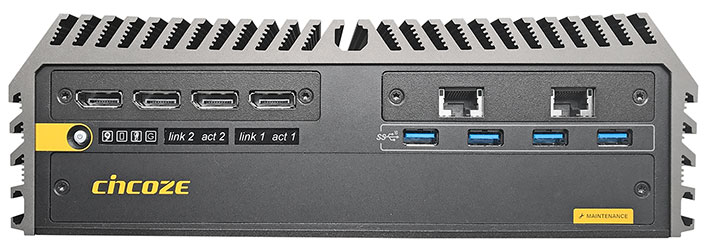
As is the case with many industrial and panel PCs, the Cincoze GM-1000's I/O is in the back and in the front and nowhere else. That's because the unit is designed to be either sitting flat or mounted on a wall, so that large finned heat sink is freely exposed to cooling air. Our review Cincoze GM-1000 provided the following external ports on the front:
- 4 x DisplayPort
- 4 x USB 3.2 Gen 2
- 2 x RJ45 10GbE LAN
- 1 x SIM card slots
- 1 x Power button
- 2 x SIM card slots
- 2 x 2.5-inch Hot Swap HDD/SSD bays
- Reset button, ignition setting switch, power mode switch (AT/ATX)
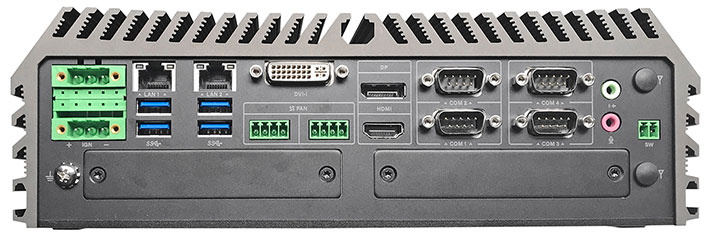
In the rear, our review Cincoze GM-1000 provided the following external ports:
- Dual DC-In 3-pin terminal power blocks for up to 360W power draw
- 2 x RJ45 gigabit LAN
- 1 x DVI-I digital video port
- 4 x USB 3.2 Gen 1
- 1 x DisplayPort
- 1 x HDMI
- 4 x RS232/422/485 DB9 serial ports
- 1 x Audio Line out
- 1 x Audio Microphone in
- 1 x 2-pin remote power on/off connector
- 2 x Universal I/O expansion bays
- 2 x Antenna cutouts
- 2 x 4-pin external fan power blocks
Due to the widely varying requirements of industrial customers, Cincoze also offers a wide range of optional modules and I/O. These include either an Nvidia Quadro P2000 or AMD Radeon E9174 MXM kit, numerous CMI and CFM modules (LAN, DIO, serial, PoE, power ignition sensing, more) with standard or M12 connectors, as well as a number of Mini-PCIe modules (serial, LAN, USB).
A peek inside
Needless to say, we opened up the Cincoze GM-1000 to see how it's built and what it looks like inside.
The housing consists, as is usually the case with such industrial Box PCs, of steel plates and massive aluminum heat sinks (it weighs well over five pounds all by itself) with prominent finning.
Below you can see the bottom of the unit, with the bottom cover in place (left) and with the bottom cover removed (right). There's room here for a couple of 2.5-inch SATA hard or solid state hot-swappable disks. RAID 0 (striping), 1 (mirroring), 5 (striping with parity) and 10 (combined mirroring and striping) configuration is possible with dual disks. You can also see the two Mini PCIe/mSATA connectors that can be used for wireless modules, and the M.2 M Key 2280 socket that supports fast NVMe SSDs (using a CERVOZ module in our test unit).
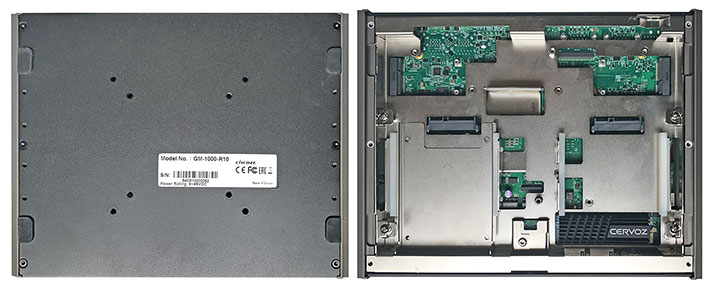
Open four additional latches and you can pull out and separate the chassis with all the electronics from the massive heat sink. This reveals one of the secrets of the Cincoze GM-1000. The heatsink is not just the common extruded aluminum affair; it actually has copper heat piping integrated in it, and also copper plates. On the right side is a look at the top side of the motherboard, where heat generating components have their own copper and aluminum heatsinks (we removed the thermal pads for better vierwing).
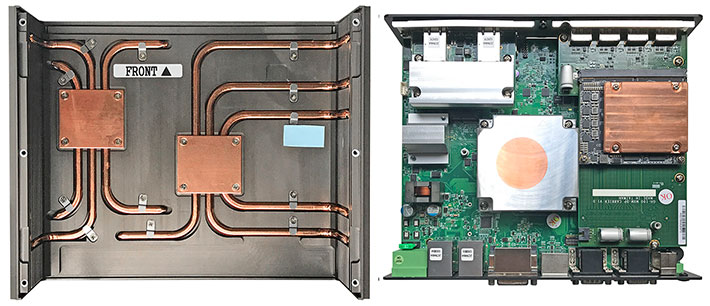
Looking at the GM-1000 motherboard, note that Cincoze uses an MXM interface for optional graphics expansion. MXM is short for Mobile PCI Express Module, and is an interconnect standard for graphics modules. MXM uses a carrier board that then accommodates an MMX-based module. You can see it on the motherboard on the right, with the copper heatspreader sitting on top of the GPU module.
We like that Cincoze is handling the MXM interface via carrier board instead of plugging MXM modules directly to the mother board. The carrier board approach allows for easy upgrades and different MXM module form factors.
Cincoze also uses proprietary CMI interfaces. CMI stands for Combine Multiple I/O, and the GM-1000 offers one high-speed (LAN) and one low-speed (serial, DIO) CMI. This allows them to combine multiple I/O threads in a single port, using M12 connectors.
The big challenge in this type of compact industrial computer design is thermal management. With no fans there is no active airflow, and so heat generated by components must be collected and spread through heatsinks, and then somehow dissipated. This warrants some explanation and commentary.
According to the second law of thermodynamics, heat flows from warmer places to colder ones in an attempt to equalize the temperature difference, similar to higher water levels flowing to lower ones in an effort to have a qual surface elevation.
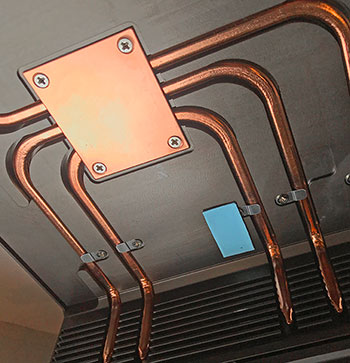 Almost all materials conduct heat, albeit to greatly varying degrees. Thermal conductivity is measured in watts per square meter of surface area for a temperature gradient of one degree Kelvin through a distance one meter. Almost all materials conduct heat, albeit to greatly varying degrees. Thermal conductivity is measured in watts per square meter of surface area for a temperature gradient of one degree Kelvin through a distance one meter.
When it comes to heat sinks and heat pipes in computers, the materials used are generally aluminum and copper. Copper offers about 70% higher thermal conductivity than aluminum, but costs about three times as much as aluminum, and coppers weighs more than three times as much.
As a result, copper is primarily used for heat pipes guiding heat away from CPUs and other heat generating electronics. Copper is also used for small thermal conducting plates and such. Aluminum, on the other hand, is frequently used to dissipate heat on the outside of industrial computers, with heavily finned surfaces creating as much heat-dissipating surface as possible.
So both materials have their place, but by and large, systems designers use either one or the other. Cincoze, however, decided to use both, taking advantage of the special properties of each metal.
In the GM-1000 Cincoze used a hybrid copper aluminum design where copper heat plates make contact with heat-generating components via conductive pads, the copper heat plates each have several copper heat pipes attached to them, and those copper heat pipes are then secured into grooves in the aluminum heat sink/spreader. This way, more heat gets removed faster. And just to make sure, Cincoze provided heat isolation between the CPU and the GPU.
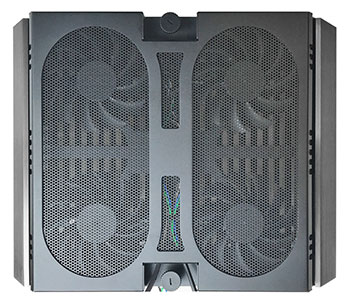 This is quite elaborate, ingenious, and excellently executed. However, you might say, passive cooling is just that, passive. What if ambient air around a Cincoze GM-1000 gets hot? What if it encounters extended workload peaks? Without scalable active cooling, won't the system overheat/slow down anyway? And what about processor and options selection? Can even the best passive cooling handle all that? This is quite elaborate, ingenious, and excellently executed. However, you might say, passive cooling is just that, passive. What if ambient air around a Cincoze GM-1000 gets hot? What if it encounters extended workload peaks? Without scalable active cooling, won't the system overheat/slow down anyway? And what about processor and options selection? Can even the best passive cooling handle all that?
The answer is, as almost always, it depends. Our review unit came with an Intel 9th generation Core i7-9700E octacore processor and an MXM-based Nvidia Quadro P2000 GPU. With that configuration, it barely heated up. But the i7-9700E has a modest TDP (thermal design power) of 35 watts. Cincoze offers quite a few processor options, include several with much higher TDPs of 65 watts and even 80 watts. Could the Cincoze GM-1000 passive cooling still handle that?
Probably, we don't know. But the thermal load of, say, an 80 watt Xeon 8-core/16-thread E-2278GE is considerable, and so Cincoze offers a matching external quad-fan assembly that attaches to the top of the GM-1000. The thermal images below were taken with our FLIR One Pro camera. It shows the GM-100 running benchmarks with the quad-fan installed. Temperatures didn't even reach 80F.
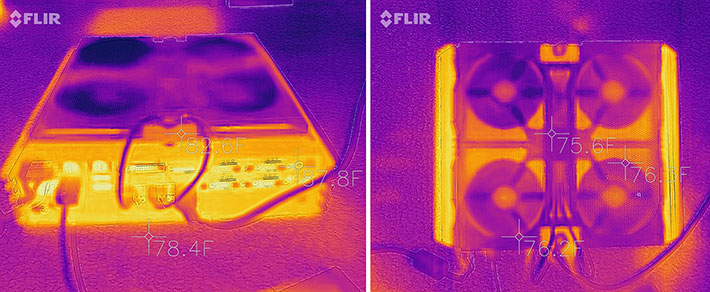
Greatly scalable performance
When Cincoze approached RuggedPCReview about hands-on with their upcoming GM-1000 they inquired as to what configuration we'd like to test. We asked them to send us the fastest, meanest, no-holds barred configuration possible. It initially looked that way, but there was a shortage of the high-end Xeon chip and in the end we got the best machine they had available for review. The octa-core/octa-thread Intel Core i7-9700TE is officially part of the Intel 9th generation "Coffee Lake-Refresh" family and was introduced summer 2019.
While Cincoze makes available a number of a couple of Xeon chips (one of them the Xeon E-2278GEL we recently benchmarked in the OnLogic Karbon 700), they also offer a variety of Core and other processors with TDPs of 35 and 65 watts. That's more than the maximum of 15 watts that's common in rugged mobile laptops and tablets today, but in the overall sceme of things, 35 watts doesn't present a challenging thermal load and thus is quite suitable for fanless operation.
To provide an idea of the relative performance of the so-equipped Cincoze GM-1000, we ran our two standard benchmark suites, PassMark (both versions 6.1 and 9.0) and CrystalMark. For comparison, we're also listing the results of the OnLogic Karbon 700, the much smaller Karbon 300, as well as a high-powered ARBOR industrial PC we tested a couple of years ago.
|
Cincoze GM-1000 Benchmarks and Comparisons
|
|
PERFORMANCE COMPARISON
|
Cincoze
|
OnLogic
|
OnLogic
|
Arbor
|
|
Model
|
GM-1000
|
Karbon 700
|
Karbon 300
|
FPC-8002
|
|
Model
|

|

|

|

|
|
Year tested
|
2020
|
2019
|
2019
|
2018
|
|
Intel processor
|
Core i7-9700TE
|
Xeon E-2278GEL
|
Atom E3950
|
Core i7-7700T
|
|
Cores/threads
|
8/8
|
8/16
|
4/4
|
4/8
|
|
CPU base speed
|
1.80GHz
|
2.00GHz
|
1.60GHz
|
2.90GHz
|
|
CPU turbo speed
|
3.80GHz
|
3.90GHz
|
2.00GHz
|
3.8GHz
|
|
Thermal Design Power (TDP)
|
35.0 watts
|
35.0 watts
|
12.0 watts
|
35.0 watts
|
|
PassMark 6.1
|
6,601.1
|
5,629.7
|
1,347.9
|
3,456.8
|
|
PassMark 9.0
|
4,096.0
|
3,904.2
|
1,030.6
|
3,041.0
|
|
Overall CrystalMark
|
362,403
|
406,787
|
143,195
|
274,715
|
The results show three things:
- First, the 9th gen octa-core Intel Core i7-9700TE equipped Cincoze GM-1000 provides excellent performance, scoring overall higher than any of the mobile rugged systems we're usually testing here at RuggedPCReview.com. And the GM-1000 even beat the Xeon-powered Karbon 700, mostly due to faster memory and storage. For a fanless industrial PC that's quite an accomplishment, and it shows how careful selection of state-of-the-art high-performance components can really shine.
- Second, as fast as the Intel Core i7-9700TE is, it's not the fastest chip Cincoze offers for the GM-1000. The two available Xeon processors, the 65 watt Core i7-9700E and probably the also 65 watt Core i7-9500E will be faster yet, albeit at a higher Thermal Design Powers.
- And third, Cinzose's very wide range of CPU options shows once again how important it is to spec industrial PCs not on lowest price, but on getting the exact right processor for the job. That may be the lowest-end chip or it may be one of the high-end chips.
I should also mention that we ran benchmarks both with and without the extra quad-fan active smart cooling. There were no statistically significant differences. This means that with a 30 watt TDP processor, the unit likely will not need the fan in most deployments.
To help with that decision, peruse the table below. It shows all the different 9th generation processors available for the Cincoze GM-1000 (for full Intel spec table, click here).
|
Cincoze GM-1000 Intel 9th Gen Coffee Lake-R processor options
|
|
PROCESSOR OPTIONS
|
Xeon
|
Xeon
|
Core i7
|
Core i5
|
Core i3
|
Core i7
|
Core i5
|
Core i3
|
|
Model
|
E-2278GE
|
E-2278GEL
|
9700TE
|
9500TE
|
9100TE
|
9700E
|
9500E
|
9100E
|
|
Cores/Threads
|
8/16
|
8/16
|
8/8
|
6/6
|
4/4
|
8/8
|
6/6
|
4/4
|
|
Base Clock Speed
|
3.30 GHz
|
2.00 GHz
|
1.80 GHz
|
2.20 GHz
|
2.20 GHz
|
2.60 GHz
|
3.00 GHz
|
3.10 GHz
|
|
Turbo Speed
|
4.70 GHz
|
3.90 GHz
|
3.80 GHz
|
3.60 GHz
|
3.20 GHz
|
4.40 GHz
|
4.20 GHz
|
3.70 GHz
|
|
Cache
|
16MB SmartCache
|
16MB SmartCache
|
12MB SmartCache
|
9MB SmartCache
|
6MB SmartCache
|
12MB SmartCache
|
9MB SmartCache
|
6MB SmartCache
|
|
Thermal Design Power (TDP)
|
80 watts
|
35 watts
|
35 watts
|
35 watts
|
35 watts
|
65 watts
|
65 watts
|
65 watts
|
|
Graphics base speed
|
350 MHz
|
350 MHz
|
350 MHz
|
350 MHz
|
350 MHz
|
350 MHz
|
350 MHz
|
350 MHz
|
|
Graphics max speed
|
1.20 GHz
|
1.20 GHz
|
1.15 GHz
|
1.10 GHz
|
1.05 GHz
|
1.15 GHz
|
1.10 GHz
|
1.05 GHz
|
|
Intel vPro
|
Yes
|
Yes
|
Yes
|
Yes
|
No
|
Yes
|
Yes
|
No
|
|
Intel TSX-NI
|
Yes
|
Yes
|
Yes
|
Yes
|
No
|
Yes
|
Yes
|
No
|
|
Intel SIPP
|
NA
|
NA
|
Yes
|
Yes
|
No
|
Yes
|
Yes
|
No
|
|
Intel Trusted Execution
|
Yes
|
Yes
|
Yes
|
Yes
|
No
|
Yes
|
Yes
|
No
|
|
Relative CPU Cost
|
4.05
|
4.05
|
2.65
|
1.57
|
1.00
|
2.65
|
1.57
|
1.00
|
What may make a difference in certain applications is the availability of four special Intel technologies (vPro, TSX-NI, SIPP, and Trusted Execution) included in some of the available processors but not in others. Here's what that means:
The extra security and manageability capabilities of vPro, especially, are required in many enterprise deployments.
- TSX-NI (Transactional Synchronization Extensions New Instructions) helps make parallel operations more efficient via improved control of locks in software,
- SIPP (Stable Image Platform Program) allows deployment of standardized, stable image PC platforms for at least 15 months, and
- Trusted Execution technology provides security capabilities such as measured launch and protected execution, and may thus also be an enterprise requirement.
As far as "relative CPU" cost goes, it means that while Intel charges its customers 1X dollars for the low-end processors available for the Cincoze GM-1000, it charges four times as much for the highest-end processors. This, of course, has an impact on overall system cost.
Note that in our tablet above we only listed the GM-1000's available 9th generation Intel "Coffee Lake-R" processor options. Also available are a full dozen 8th generation CPUs, ranging all the way from high-powered Xeon workstation class processors all the way down to economical Pentium and Celeron G-Series versions.
Ruggedness
From a ruggedness standpoint, industrial Box PCs such as the Cincoze GM-1000 may encounter temperatures extremes, shock/vibration, and airborne particulates. Since they are not carried around, the drop spec and IP rating (sealing against solids and liquids) that in part define the durability of mobile devices are essentially irrelevant. Shock and vibration resistance, however, are not, and those have been tested to IEC 60068- 2-27 and IEC 60068-2-64 procedures, respectively. The operating temperature range can be as wide as -40°F to 158°F, depending on processor and cooling method.
Overall, Cincoze observed proper rugged design principles for this type and class of machine, including the unibody chassis, cable- and jumper-less design as well as integrated anti-vibration measures. They also sought to comply with all pertaining EN 50121-3-2 (EN 50155) rolling stock, E-Mark, and EN62368-1 safety rolling stock standards to ensure stable and reliable performance of the unit. That also included fanless design, medical-grade ESD and interference protection, solid-state components as well as wide 9-48VDC input voltage support.

Ruggedness also requires secure mounting methods. Here, the Cincoze GM-1000 has 75mm and 100mm VESA mount patterns as well as available DIN-rail mounting, wall mount brackets, and and a side mount kit. There's reverse power input protection, ESD and surge protection, over-current and over-voltage protection, and an super capacitor so that there won't ever be issue with a dying CMOS battery.
Faster storage
On the mass storage side, the Cincoze GM-1000 is ahead of much of the competition. That's because it makes available PCIe NVMe instead of, or in addition to, older, slower SATA-based storage technology. To explain the advantage of that we must backtrack a little. For decades, hard disks served as mass storage almost exclusively. Hard disks are complex mechanical devices with rotating platters and fragile read heads. Wear and tear is an issue with hard disks, as are disk crashes due to vibration or impact. For that reason, hard disks were increasingly replaced by faster and less vulnerable SSDs — solid state drives — in many (and now most) applications.
However, even SSDs have their bottlenecks. In terms of performance, for some time now that bottleneck has been the SATA interface between the storage module and the computer. SATA's been around for a decade and a half and data transmission speed has pretty much maxed out.
The PCIe standard, on the other hand, can reach throughput speeds up to several times higher, depending on which PCIe standard is used and how many "lanes" are available. And PCIe doesn't even require major changes. The standard M.2 connector supports both SATA and PCIe, and PCIe storage modules are the same "gumstick" size as SATA storage modules.
The Cincoze GM-1000
With the GM-1000, Cincoze an amazingly versatile industrial Box PC system with a footprint barely larger than an iPad. Yet, despite its very compact size, the GM-1000 is a vastly scalable package that can be configured with your choice of no fewer than 20 Intel 8th and 9th generation Xeon, Core, Pentium and Celeron processors.

The Cincoze GM-1000 offers plenty of onboard wired communication to fit just about any application, augmented by Combined Multiple I/O interface options as well as ignition sensing for vehicular applications. There is plenty of storage, ranging from dual 2.5-inch SATA HDDs or SDDs, as well as multiple mSATA and NVME SSD sockets. Thanks to embedded MXM GPU expansion, the GM-1000 is suitable for any number of machine vision and similar graphics recognition and processing applications. Also impressive is the superb product documentation and manual.
-- Conrad H. Blickenstorfer, July 2020
Cincoze GM-1000 Specs:
| Status |
Added and reviewed 07/2020
|
| Type |
High-performance embedded GPU edge computer
|
| CPU Type |
Xeon E-2278GE: 8 cores/16 threads
Xeon E-2278GEL: 8 cores/16 threads
Core i7-8700E: 8 cores/8 threads
Core i5-8500E: 6 cores/6 threads
Core i3-8100E: 4 cores/4 threads
Core i7-8700E: 8 cores/8 threads
Core i5-8500E: 6 cores/6 threads
Core i3-8100E: 4 cores/4 threads
|
| CPU speed |
Xeon E-2278GE: 3.30 default/4.70GHz max turbo frequency
Xeon E-2278GEL: 2.00 default/3.90GHz max turbo frequency
Core i7-8700E: 2.80 default/3.80GHz max turbo frequency
Core i5-8500E: 2.20 default/3.60GHz max turbo frequency
Core i3-8100E: 2.20 default/3.20GHz max turbo frequency
Core i7-8700E: 2.60 default/4.40GHz max turbo frequency
Core i5-8500E: 3.00 default/4.20GHz max turbo frequency
Core i3-8100E: 3.10 default/3.70GHz max turbo frequency
|
| Graphics |
Xeon E-2278GE: Intel UHD Graphics 630
Xeon E-2278GEL: Intel UHD Graphics 630
Core i7-8700E: Intel UHD Graphics 630
Core i5-8500E: Intel UHD Graphics 630
Core i3-8100E: Intel UHD Graphics 630
Core i7-8700E: Intel UHD Graphics 630
Core i5-8500E: Intel UHD Graphics 630
Core i3-8100E: Intel UHD Graphics 630
|
| optional MXM GPU |
Nvidia Quadro P2000 or AMD Radeon E9174
|
| OS |
Windows 10, Linux
|
| Memory |
Up to 64GB DDR4-2666/2400 MHz LPDDR4 in two SO-DIMM sockets
|
| Watchdog Timer |
Software programmable supports 256 levels, system reset |
| Graphics Interface |
Supports triple independent display (DVI-I/DisplayPort/HDMI); exact configuration depends on options
|
| LAN |
3 x GbE LAN (2 of them optionally PoE), Intel I210IT GbE LAN controller
2 x GbE LAN ports (Intel® I219-LM and Intel® I210-IT; supports WoL, Teaming, Jumbo Frame & PXE)
|
| Expansion |
1 x mPCIe, 1 x mPCIe/mSATA, 1 x M.2 2230, 1 x M.2 2230/60/80, 1 x M.2 2280, 1 x PCIe riser
1 x High Speed CMI interface for I/O expansion, 1x Low Speed CMI interface, 1 x CFM IGN Interface, 1 x MXM carrier board interface for MXM GPU module expansion, 1 x PCIe x2 M.2 Key E 2230 socket, 3 x full-size Mini-PCIe sockets, 2 x SIM sockets
|
| Primary Storage |
2 x SATA III (6Gbps) front-accessible 2.5" HDD/SSD trays (up to 15mm in Height)
3 x mSATA Sockets (shared by Mini-PCIe socket), supports S/W RAID 0, 1, 5 & 10,
1 x PCIe x4 M.2 Key M 2280 Socket, supports NVMe SSD
|
| Housing |
Steel case with finned aluminum heatsinks, copper heat piping, wall/DIN/side mount, 75mm/100 mm VESA
|
| Vibration |
Tested according to MIL-STD-810G, Method 514.6, Category 4, Common Carrier over US Highways 1 hour per axis, 3 axes
|
| Shock |
Tested according to MIL-STD-810G, Method 516.6 for Ground Level Equipment 40g, 11ms, sawtooth, 3 pulses positive and negative per axis, 3-axis, operating
|
| Humidity |
10% ~ 95%
|
| Regulatory |
2011/65/EU (RoHS 2 Directive)
Additional Safety and EMC certifications pending, CE, EN 55024, EN 55032, EN 62368-1, FCC 47 CFR Part 15, IEC 60068-2-27, IEC 60068-2-64
|
| Operating temperature |
-40°F to 104 to 158°F (-40°C to 40 to 70°C), depending on processor TDP and cooling
|
| USB |
4 x USB 3.2 gen1 (5Gbps) Type-A, 4 x USB 3.2 gen2 (10Gbps)
|
| Serial |
4 x RS232/422/485 serial |
| Digital I/O |
Optional
|
| CAN Bus |
NA
|
| Audio |
1 x Line-out & 1 x Mic-in, Phone Jack 3.5mm |
| Size |
10.2 x 7.9 x 3.35 inches (260 x 200 x 85 mm)
|
| Weight |
11.9 lbs (5.4 kg) as tested (incl. quad-fan) |
| Power |
Wide-input 9 to 48 VDC with automotive intelligence, dual 3-pin Terminal Block connectors with 360 watt total power budget
|
| Certifications |
EMC: CE/FCC Class A, EN 50121-3-2, E-mark (pending); Safety: LVD (EN62368-1)
|
| Price |
Inquire |
| Webpage |
Cincoze GM-1000 page |
|




